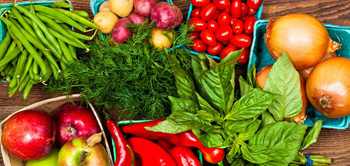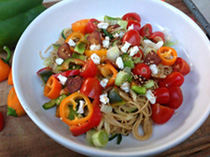Why REAL Food?
You may not be aware. The Center for Science in the Public Interest (CSPI) advises that Americans avoid 24 widely used food additives while urging us to cut back on 51 more. These 75 unsavory additives are meant to make our food prettier, creamier, tastier and stay fresh and safe longer. Instead they may be contributing to our nation’s health crises. Obesity, diabetes, heart disease, cancer, and even attention deficit disorder, depression and Alzheimer’s can be linked to chemicals in processed foods.
Yet many persist in consuming these additives. Why? Taste and convenience. From the color, to the texture, to the chemically balanced sweet/tart/salty/fatty flavors, topped with grab-and-go availability, we are hooked. In fact, The End of Overeating author David Kessler, MD, writes that hyper-palatable foods – those manufactured to be high in any combination of fat, sugar, and salt – can literally “rewire” the circuitry in our brains, creating true food addictions.
What’s on this list of food additives that we should steer clear of?
You are probably familiar with some: partially hydrogenated oils, high fructose corn syrup, monosodium glutamate, sodium nitrates and artificial colors like Red Dye numbers 3 and 40. Others might be surprising: caramel coloring (Coke and Pepsi), potassium bromate (some breads), BHA (potato chips and cereals) and TBHQ (crackers and frozen foods). View CSPI’s entire list at www.cspinet.org/reports/chemcuisine.htm
How can we protect ourselves from harmful food additives?
 Plan A: You could carry CSPI’s extensive list to the store, read every packaged food label, search for the unpronounceable words, then put items back on the shelf. Besides being an exhaustive task, the list changes frequently as new data is acquired. A chemical additive that is not on the list today might very well be there tomorrow (examples include NutraSweet, Splenda, Red Dye #40 and carrageenan).
Plan A: You could carry CSPI’s extensive list to the store, read every packaged food label, search for the unpronounceable words, then put items back on the shelf. Besides being an exhaustive task, the list changes frequently as new data is acquired. A chemical additive that is not on the list today might very well be there tomorrow (examples include NutraSweet, Splenda, Red Dye #40 and carrageenan).
Or Plan B (recommended): You could adopt a “no processed foods” rule of thumb that focuses on whole, REAL food first, then supplement with safe, minimally processed foods to keep life realistic.
In other words, Eat REAL Food!

What is REAL Food?
 REAL food grows from the ground or in a tree, swims in the ocean or grazes on the prairie. It then “stays close to the farm” by avoiding unnecessary chemical processing and therefore remains as close to its natural state as possible. It includes fresh or frozen vegetables and fruits, fresh fish and meats, whole grains, nuts, minimally processed dairy and oils, and herbs and spices. It also includes bread and canned and jarred foods with clean whole food ingredients and minimal (and safe) additives. Eating REAL doesn’t mean you have to grow your own ingredients and cook everything from scratch.
REAL food grows from the ground or in a tree, swims in the ocean or grazes on the prairie. It then “stays close to the farm” by avoiding unnecessary chemical processing and therefore remains as close to its natural state as possible. It includes fresh or frozen vegetables and fruits, fresh fish and meats, whole grains, nuts, minimally processed dairy and oils, and herbs and spices. It also includes bread and canned and jarred foods with clean whole food ingredients and minimal (and safe) additives. Eating REAL doesn’t mean you have to grow your own ingredients and cook everything from scratch.
Are there studies that support the health benefits of REAL food?
Yes. Many studies demonstrate that diets low in processed foods, like the Mediterranean Diet and the D.A.S.H. (Dietary Approach to Stopping Hypertension) Diet, all work to save lives. What’s the overarching “take-away” of each of these noted disease-fighting studies? Eat unprocessed, REAL food.
REAL food reduces risk of obesity and disease.
Here’s how. REAL foods:
1. Promote, rather than displace, fruit and veggie consumption.
Produce is a REAL food staple, the flavors, colors, and textures of which become enjoyable when highly processed foods are removed from the palate. Processed foods are notoriously nutrient-poor, calorie-dense and additive-laden, while fruits and veggies are just the opposite. A win for your waistline and health!
2. Taste great, while “re-wiring” and eliminating your need for “addictive” flavors.
Food prepared with a variety of herbs, spices, and fresh ingredients intensifies inherent flavors, and reduces your cravings for the fat, sugar, salt and additives often found in processed foods, all known to be disease promoting in excess. Hoping to nix your sweet tooth? REAL foods will do just that!
3. Make you feel full on less.
Weight loss and disease reduction are expected outcomes of REAL food consumption. This is in part due to the digestion-healthy and satiety-producing fiber and the overall improved nourishment that REAL plant foods provide.
4. Provide a variety of disease-fighting nutrients.
Superfoods like avocados, sweet potatoes, spinach, kale, Brussel’s sprouts, pomegranates, mangoes, legumes, quinoa, salmon, trout, shrimp and lean pork, beef and chicken are all REAL foods that top the charts for beneficial nutrients like antioxidants and omega three fatty acids, all known to keep your heart, gut, brain, and muscles healthy.
Resources to help you leap into the REAL food world:
- My cookbook, Lickety-Split Meals, is an awesome first step to begin including vegetable-rich meals in your daily menu.
- The 8 Habits taught in my 10-week DIET FREE Lifestyle Program steps you into REAL food by systematically cleaning up your diet while also providing the nutrition education that makes the changes stick.
 I teamed up with REAL Food Champion, Krista Sanderson, to create Eat REAL for Your Health, a program that will help you confidently choose, prepare and eat REAL food, driving down disease deliciously! Included in this program is our coauthored Eat REAL Cookbook and membership to EatRealAmerica.com, which provides over 1,000 REAL food recipes, twice weekly coaching messages, and a library of how-to resources.
I teamed up with REAL Food Champion, Krista Sanderson, to create Eat REAL for Your Health, a program that will help you confidently choose, prepare and eat REAL food, driving down disease deliciously! Included in this program is our coauthored Eat REAL Cookbook and membership to EatRealAmerica.com, which provides over 1,000 REAL food recipes, twice weekly coaching messages, and a library of how-to resources.
What’s most important is that you run, don’t walk, from harmful food additives!
No matter how you get your support for eating REAL food, you will love the health and weight loss benefits that wholesome foods provide!
